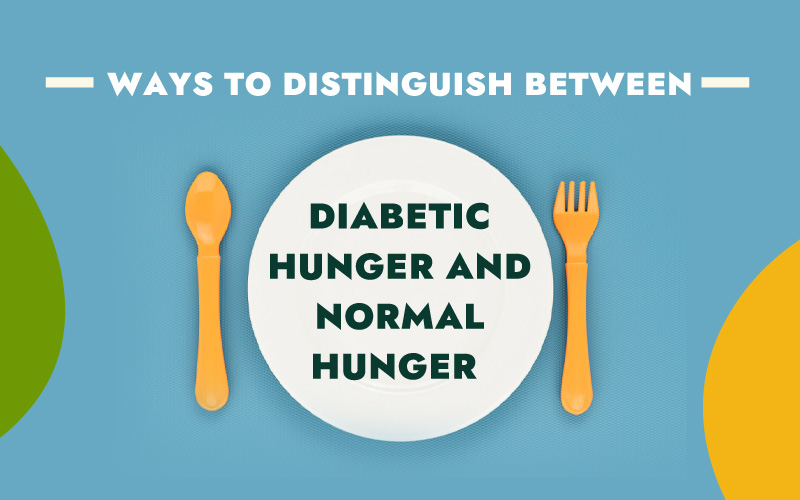
Hunger is a natural sensation the body uses to signal that it needs food. It is crucial to maintain a healthy body and a balanced diet. But there are different types of Hunger. Understanding their differences is essential, especially for people with diabetes. This article will explore the differences between normal Hunger and diabetic Hunger. Keeping track of your hunger pattern might help diagnose diabetes in its early stage (Also Read 11 Important Signs & Symptoms That You Should Never Ignore When Your Blood Sugar Is Going Out of Control). We will also discuss ways to distinguish between the two and how to manage diabetic Hunger.
Characteristics of Normal Hunger

Have you ever felt that grumbling in your stomach when you haven’t eaten in a while? That’s your body telling you that it needs more energy! Normal Hunger is a natural and healthy sensation. It signals our bodies to look for food to replenish our energy levels.
Our blood sugar levels drop when we don’t eat for a while. Our body responds to this by releasing a hormone called ghrelin. This hormone stimulates the hunger sensation and tells our brain it’s time to eat. Once we start eating, our stomach signals to our brain that it’s complete by releasing leptin. This tells our brain that it’s time to stop eating.
In short, normal hunger is the feeling of needing to eat when our body needs more energy. Hormones regulate that tell our brain when to start and stop eating.
Causes of Normal Hunger
When we go without eating for a while, our body’s energy reserves run low. This triggers a chain reaction of signals to our brain to look for food to replenish those reserves. Here are some of the causes of normal Hunger:
Decreased blood sugar levels
Our body runs on glucose, which comes from the food we eat. Our blood sugar levels drop when we haven’t eaten in a while. Our body responds to this by seeking out food to replenish those levels.
Hormones
The body releases a hormone called ghrelin. This hormone increases appetite and signals the brain to seek out food. This hormone handles our Hunger pangs when we haven’t eaten.
Empty stomach
As the stomach empties, it produces a hormone called ghrelin, which signals to the brain that it’s time to eat.
Symptoms of Normal Hunger
The symptoms include stomach growling, weakness, dizziness, headaches, and difficulty concentrating. These symptoms result from the body’s decreased blood sugar levels. They show the need to replenish the body’s energy reserves.
Differences between Normal Hunger and Diabetic Hunger
Normal Hunger is a natural sensation that occurs when the body needs food. But, diabetic Hunger results from the body’s inability to use insulin. Diabetic Hunger is often accompanied by high blood sugar levels and fatigue. Here are some more differences between normal hunger and diabetic hunger.
Normal Hunger:
- A natural sensation that occurs when the body needs food.
- Caused by decreased blood sugar levels, hormones, and an empty stomach.
- Often accompanied by a growling stomach or a feeling of emptiness.
- Eating food relieves the normal Hunger
- Does not lead to high blood sugar levels.
Diabetic Hunger:
- A result of the body’s inability to use insulin.
- Often accompanied by high blood sugar levels and fatigue or lethargy.
- Can occur even when blood sugar levels are normal.
- Can be mistaken for normal Hunger.
- Can lead to complications if left untreated.
Characteristics of Diabetic Hunger

Diabetic Hunger is a sensation of Hunger due to high blood sugar levels. When the body cannot use insulin, glucose levels in the blood rise. This leads to a feeling of Hunger.
Causes of Diabetic Hunger
When the body cannot use insulin, it results in Diabetic Hunger. Insulin is a hormone that regulates blood sugar levels. But when the body cannot use it, glucose levels in the blood rise. This leads to diabetic Hunger.
Symptoms of Diabetic Hunger
Some common symptoms of Diabetic Hunger include:
A feeling of Hunger
Unlike normal Hunger, diabetic Hunger may persist even after eating. It can be intense and difficult to ignore.
Increased thirst: High blood sugar levels can cause dehydration. This leads to a feeling of constant thirst. This may result in increased fluid intake, leading to frequent urination.
Fatigue
Due to the body’s inability to use insulin, cells do not receive the required energy to function. This can lead to fatigue and lethargy.
Frequent urination:
High blood sugar levels cause the kidneys to work harder to filter and remove excess glucose. This leads to an increase in urine production and may result in more frequent trips to the restroom.
Differences between Diabetic Hunger and Normal Hunger
- Normal Hunger is a natural sensation when the body needs fuel. But diabetic Hunger results from the body’s inability to use insulin.
- Diabetic Hunger is often accompanied by high blood sugar levels, unlike normal Hunger.
- You can meet normal Hunger can by eating any food. But Hunger requires a more mindful approach to food choices and portion control.
- People experiencing diabetic Hunger may feel fatigued or lethargic. But those experiencing normal Hunger may feel a slight grumble in their stomach.
- Diabetic Hunger is a symptom of diabetes. It indicates the need for adjustments to medication or diet. But normal Hunger is a sign that the body needs fuel.
[Also Read: Managing Type 2 Diabetes without Insulin; 10 Important Things To Know]
Ways to Distinguish Between Diabetic Hunger and Normal Hunger

Distinguishing between diabetic Hunger and normal Hunger is vital. This helps a potential diabetes patient identify early signs and get better treatment. Here are some ways to differentiate between the two:
Monitoring Blood Sugar Levels
Monitoring blood sugar levels can help distinguish between diabetic Hunger and normal Hunger. People with diabetes should check their blood sugar levels. This ensures they are within the normal range. High blood sugar levels or show diabetic Hunger. But, low blood sugar levels show normal hunger.
[Also Read: Blood Glucose Monitoring for Diabetics | Blood Sugar Testing]
Keeping Track of Hunger Patterns
You can distinguish between normal and diabetic Hunger by tracking hunger patterns. Normal Hunger tends to occur at regular intervals. A rumbling sensation in the stomach usually accompanies it. Factors like physical activity can also trigger normal Hunger.
But diabetic Hunger may occur unexpectedly. It may occur even when the person has recently eaten. It may also accompany other symptoms, such as sweating, shaking, or dizziness.
Keeping a food diary or journal can help identify patterns of Hunger. It can also help determine whether they are normal or related to diabetes.
Identifying Triggers for Hunger
Another way to distinguish between normal and diabetic Hunger is the Hunger-triggers. Normal Hunger may result from factors like the time of day, physical activity, or an empty stomach.
Changes in Blood Sugar levels can trigger Diabetes Hunger. If a diabetic person skips a meal or eats a high-carb meal, their blood sugar levels alter. This can lead to feelings of Hunger.
Managing Diabetic Hunger
Managing diabetic Hunger involves making lifestyle changes. It helps regulate blood sugar levels and promote feelings of fullness and satiety. Here are some strategies for managing diabetic Hunger:
Eating Regularly Spaced Meals
Eating regular, well-balanced meals at consistent intervals throughout the day is vital. It can help regulate blood sugar levels and prevent sudden drops or spikes. This means avoiding long fasting periods and eating meals high in protein and fiber.
Incorporating Healthy Food Choices
Incorporating healthy food choices into your diet can also help manage diabetic Hunger. This includes choosing foods low in sugar, salt, and unhealthy fats. Also, eat food high in nutrients such as fiber, vitamins, and minerals. Healthy food includes fruits, vegetables, whole grains, lean proteins, and low-fat dairy products.
[Also Read: How to Make Your Healthy Food Choices and Eating Plan]
Monitoring Carbohydrate Intake
Monitoring carbohydrate intake is also important for managing diabetic Hunger. Carbohydrates are a type of nutrient. They are broken down into sugar during digestion, which can cause blood sugar levels to rise. You can prevent sudden drops or spikes in blood sugar by monitoring your carb intake.
Conclusion

Managing diabetic Hunger is an essential part of diabetes management. And it starts with recognizing the differences between normal Hunger and diabetic Hunger. By understanding these two types of Hunger, you can manage them.
Overall, managing diabetic Hunger is essential. It can help manage diabetes and promote health and well-being when needed. You can manage your diabetes by making lifestyle changes and seeking medical advice.

